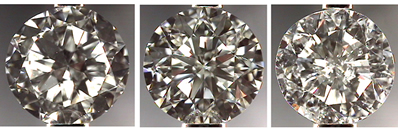Diamonds - The 4 Cs
Cut
Cut is the most important of the 4 Cs. It accounts for one half of the value of the diamond.
Cut is the most misunderstood of the 4 Cs. It is often wrongly thought of as the shape of the stone. This confusion exists because, of course, the raw material must be cut into a shape, and the confusion increases because shapes of diamonds are given names like Round Brilliant Cut, Oval Cut, Emerald Cut, and so forth.
Cut, when speaking of one of the four qualities that give diamonds their value, actually refers to the geometric proportions of the gem. The geometric proportions are important because a diamond is a prism that refracts, or bends, light rays, breaking white light into the colors of the rainbow. It is this refraction that unleashes the color spectrum in a way that gives a diamond its fire. The optical proportions must be exact in order to achieve maximum brilliance.
Light refraction
Light enters from the top of the diamond, is funneled downward where it strikes facets at the bottom, then is refracted to other facets of the stone again and again as it works its way back up, until it leaves the stone at the top and enters the eye of the observer. Cutting proportions are extremely precise to achieve the best effect.
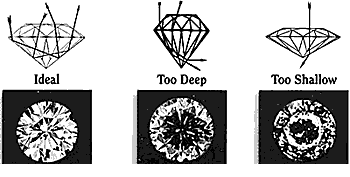
Proper Proportion
Many stone cuts lack proper proportion and refraction of light. The cut may be too heavy or too deep, allowing light to escape through the lower pavilion. If the cut is too shallow, light rays leak away at the bottom. Too much weight above or below the girdle affects the brilliance, and the stone lacks fire.
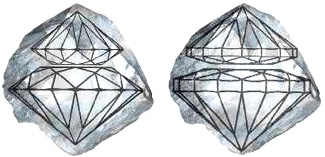
Left illustration shows two well proportioned gems cut from diamond rough. At right, the same piece of rough could yield two larger stones (greater carat weight), but they would be poorly proportioned and much less attractive.
Waste is inevitable
In cutting a gem from rough stone, the average weight loss is about 50 percent. Stones may be poorly proportioned, and may even lack symmetry, in order to retain more weight (because carat weight is what most consumers value).


A poorly proportioned diamond is like a steak with the fat left on.
A well cut diamond is like a delicious filet.
Most attractive proportions
The proportions that show the gem to best advantage have been established.
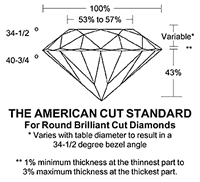
Cut and durability
The cut also affects the durability of the stone. The culet, the cut at the bottom of the diamond, is meant to flatten the point that would otherwise be vulnerable to chipping. If the culet is not present, or is too small, the stone will chip more easily.
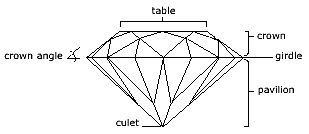
The girdle is where the setting holds the stone. If the girdle is too thin, the diamond will chip there. If the girdle is unevenly cut, the stone will be problematic to set.
The cutting grade of a diamond is determined by analyzing the proportions and symmetry through the use of instrumented and/or visual techniques. Deductions are applied for departures from the standards for table diameter, crown angle, girdle thickness, pavilion depth, culet size and centering, roundness, and finish.
Cut proportions of real stones compared to ideal proportions
| shallow |
ideal |
deep |
Click the photo to enlarge
Shopping Considerations and Caveats
- Cut, which so affects the beauty of the diamond, plays an important part in determining its value. Two finished diamonds, equal in all respects except cutting proportions, can vary as much as 50 percent in price.
 Buyer's
Tip
Buyer's
Tip
When you ask the jeweler about the cut of a diamond, the name of a shape (such as "round brilliant cut") is irrelevant. You want the geometric proportions: table diameter, crown angle, girdle thickness, pavilion depth, and culet size. You may want to take along the GemQuote™ Checklist when you go shopping.
The other 3 Cs...

